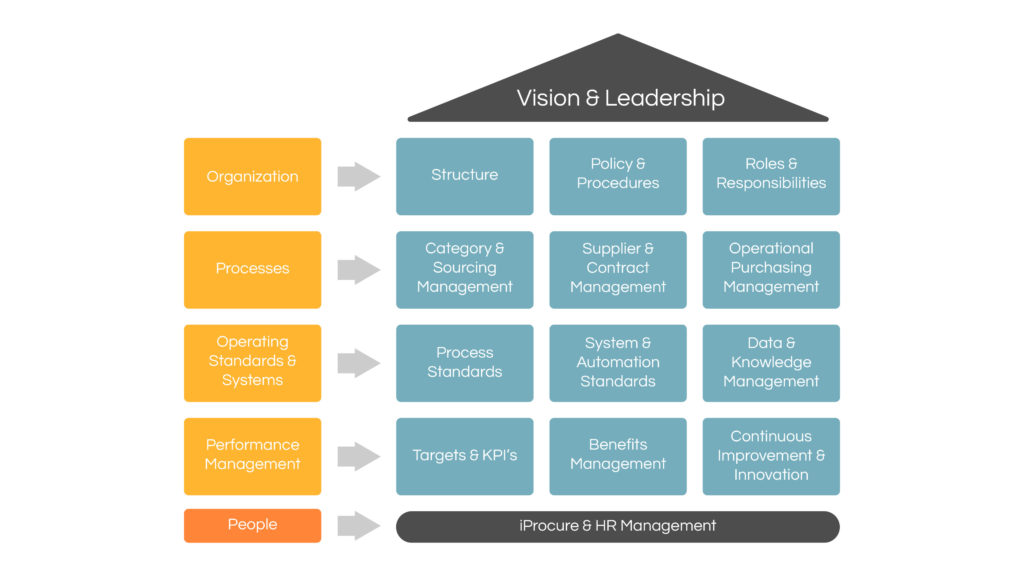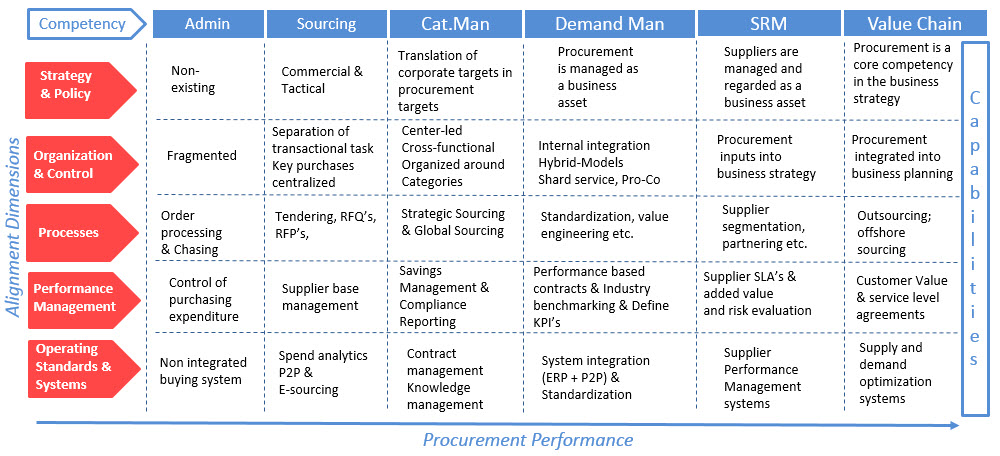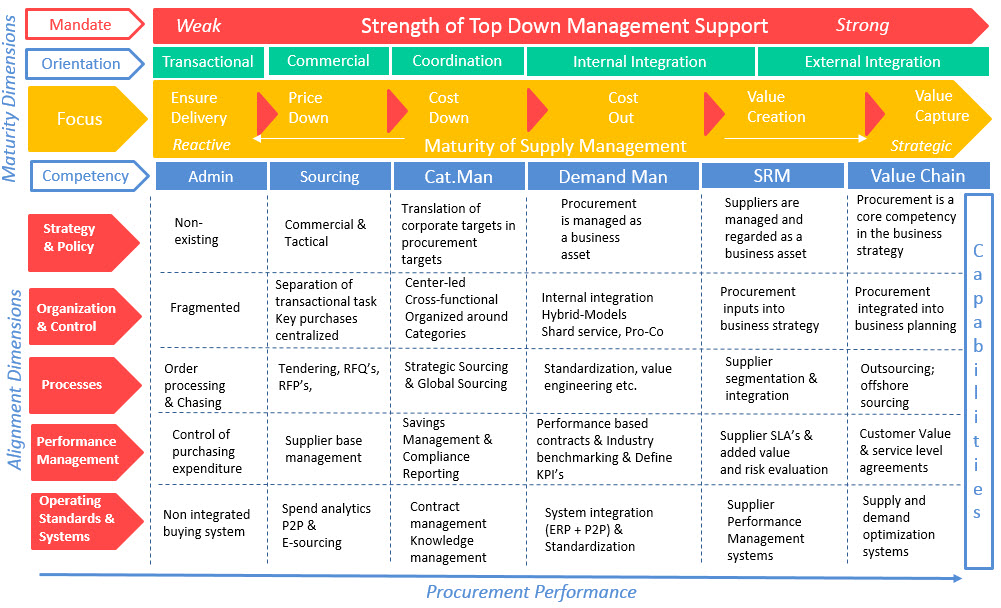Organizational alignment holds the key to the boardroom door
How to prepare procurement for true stakeholder buy-in: Whether you are a new CPO hired to transform procurement or an existing CPO looking to get true stakeholder buy-in, aligning procurement with the organization will be key to your success.
1. Preparation & Readiness
Most CPO’s will understand the strategy to transform procurement, yet many fail because of an inability to execute due to the barriers and hurdles confronting them. The organization has to be ‘prepared’, ‘made ready’, to overcome these challenges, to embed a new way of working together toward a common purpose.
So procurements values, beliefs, structure, policies, programs, strategic initiative projects, and individual objectives must align with the business and its culture.
Implementing an alignment framework is Key to organizational ‘Readiness’. It requires:
- strong top-down management support;
- a real sense of urgency;
- a strong vision;
- genuine empowerment to act;
- operationalize the new way of working.
2. CPP Procurement Operating Model
The transition from readiness to sustainable change requires an appropriate procurement operating model, each component of which requires alignment with the rest of the organization.

CPP Procurement Excellence House/CPP Capability Model
The Procurement Excellence House Model evaluates a company’s procurement across key dimensions and provides insights for improvement opportunities in procurement capabilities through:
- Key processes and level of maturity required to drive value
- Specific process improvements for achieving efficiency and effectiveness in critical procurement processes
- Systems requirements required to support the strategic and tactical activities of the procurement organization
- Procurement improvement roadmap for addressing near-term and long-term goals
The stages of maturity are especially helpful in describing what each stage looks like, to help managers identify the specific capabilities/ tools they need to add at each maturity stage to reach the next level of performance.
2.1 Mandate
Procurement’s mandate from top management reflects the degree of support the CPO has to move from the current state towards the vision for procurement.
We cannot overemphasize the criticality of support from the top. Top-down management support provides significant validation, prior to the launch of any Procurement Transformation initiative.
2.2 Skills Gap
The level of ambition reflected by the top management mandate must be matched by the procurement capabilities required to reach the desired state. By conducting a skills gap analysis, the current skills can be established and measured against those required to reach the vision.
The presence of a skills gap represents the point where the organization cannot achieve its goals because its employees do not have the right skills. Training can fill this gap.
2.3 Procurement Maturity
In general, procurement maturity is presented by depicting the growth stages that show the upward development of capability over time. With the idea that the procurement function can influence corporate profitability favorably, the functional development has been a topic of great interest.
The concept of procurement maturity provides a benchmark to measure, monitor and evaluate the professional development of procurement.
We present a framework for the capability development stages of procurement maturity as:
The assumption is that the higher the level, the more mature procurement becomes and improving an organization’s procurement maturity can contribute to the creation of sustainable competitive advantage.
2.4 Procurement alignment
Procurement connects and impacts every aspect of the business. As it develops through the maturity stages, its progress can be tracked through the following dimensions that are generic to every organization:
From an impact on organizational performance perspective, we consider each component as weighted equally. We also consider the degree of alignment as the degree to which procurement balances these dimensions with procurement maturity.
We believe that a higher degree of alignment positively influences the development of improved procurement maturity, which leads to increased procurement performance. In turn, this should be a major contributor to ‘operational excellence’ and also lead to the financial benefits expected from a successful alignment.
2.5 Benefits of Alignment
Alignment is the foundation for operational excellence and can deliver the following benefits:
- Quicker Execution of Company Strategy
- Employee Buy-in
- Increased Revenues & Operating Margins
- Greater employee engagement
- Increased Employee Retention
- Competitive Advantage
Aligning around the CPP Procurement Excellence House provides a framework for procurement excellence with the following benefits:
- Building highly capable teams as a catalyst for business alignment
- Reducing costs through category management excellence
- Creating competitive advantage through supplier capabilities
- Creating a performance management system to capture and report procurement benefits
- Investing in the procurement team to deliver sustainable superior performance
Using this model, we can select from many performance indicators and benefits. To have a manageable set, we include basic indicators per procurement level:
2.6 The Combined Maturity & Alignment Model
The procurement maturity and alignment concepts described above can be combined and together address the components of our Procurement Capability Model. The following framework depicts our Alignment and Maturity Model:
The model shows the direct relationship between procurement maturity, alignment, and procurement performance.
The alignment should run across each of the dimensions of the procurement capability model to maximize procurement’s contribution to business performance.
3. Operationalizing
A broad organizational plan for the development and roll-out time for new structures, policies, systems, processes, change management, training and development must be planned. Enforcing goal-seeking behavior requires a broad approach at every level, so it is no use focussing only on the procurement group of employees.
3.1 Tools and Guides
The availability of a toolkit to apply the new way consistently across teams is an important element of effective change management. The deployment of tools, templates and guides supports the development of a knowledge management system to support team members.
Effective knowledge management provides a common repository of “lessons learned” for application in subsequent improvement efforts.
3.2 Training
Training is the method used to bridge the skills gap and operationalize the new way of working – the toolkit.
The outcome of the skills assessment together with a toolkit, which should include process guides, frameworks, and project management tools will ensure the new way of working is executed consistently during any initiatives.
3.3 Performance Management
Procurement adds value in many ways. But if it isn’t measured – did it really happen?
Unfortunately, most procurement functions don’t track benefits. Even, fewer have a formal methodology for calculation and recognition by Finance.
The benefits go beyond reporting the value of procurement. It also facilitates proactive interventions into areas that are not working as required, so procurement can address issues before they impact the broader organization.
4. How to prepare procurement for true stakeholder buy-in
Conclusion
Many procurement initiatives fail primarily not by flawed strategic thinking, but by failure to execute. Most CPO’s understand the strategic challenges of more market share, more innovative new products, lower costs, etc. These are typically similar for most firms in an industry.
Nevertheless, procurement initiatives to support these goals often fail to improve market and financial performance. What sets the top performers apart is not the “what” but the “how”. The way they organize work to realize their aspirations.
The answer to “Why haven’t we been more successful?” usually lies inside the organization. More precisely, in the organizational model. The internal structures, decision frameworks, and operating practices that determine how work gets done.
Many of the issues faced by large companies are in fact symptoms of dynamic and complex problems embedded in the company’s organizational model over time. These problems, rooted in the economics of organizing resources are inherently complex and difficult to resolve. The resulting misalignment is not the fault of one side or the other because they evolved naturally over time toward efficiencies that made sense for each parties immediate objectives, but not for the whole company. The net result is they obstruct effective decision-making.
If aligning the procurement organization with the business strategy is necessary for success, then finding out how the organization is impeding this objective can lead to important insights about what has to change.
Nuff said …
In a series of upcoming post, we will discuss some of the key actions for the CPO to address.
If you would like to discuss how we can help you redefine your procurement, then contact us. We would love to here from you.
Learn more about gaining Procurement Excellence






